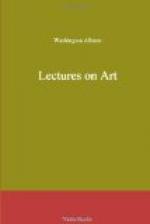We turn now to a work of the great Italian,—the Death of Ananias. The scene is laid in a plain apartment, which is wholly devoid of ornament, as became the hall of audience of the primitive Christians. The Apostles (then eleven in number) have assembled to transact the temporal business of the Church, and are standing together on a slightly elevated platform, about which, in various attitudes, some standing, others kneeling, is gathered a promiscuous assemblage of their new converts, male and female. This quiet assembly (for we still feel its quietness in the midst of the awful judgment) is suddenly roused by the sudden fall of one of their brethren; some of them turn and see him struggling in the agonies of death. A moment before he was in the vigor of life,—as his muscular limbs still bear evidence; but he had uttered a falsehood, and an instant after his frame is convulsed from head to foot. Nor do we doubt for a moment as to the awful cause: it is almost expressed in voice by those nearest to him, and, though varied by their different temperaments, by terror, astonishment, and submissive faith, this voice has yet but one meaning,—“Ananias has lied to the Holy Ghost.” The terrible words, as if audible to the mind, now direct us to him who pronounced his doom, and the singly-raised finger of the Apostle marks him the judge; yet not of himself,—for neither his attitude, air, nor expression has any thing in unison with the impetuous Peter,—he is now the simple, passive, yet awful instrument of the Almighty: while another on the right, with equal calmness, though with more severity, by his elevated arm, as beckoning to judgment,




